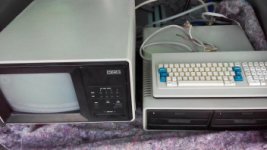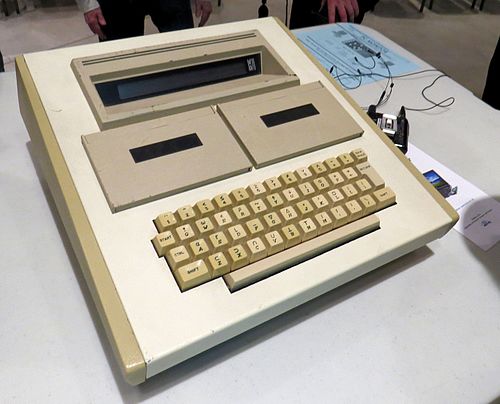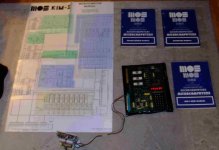My collecing (as it is) is more geared toward 1970's/early 80's pre-PC technology. I try to keep everything in extremely good physical and working condition. My favorites, although not necessarily "rare" or "valuable" items:
HP 2644A - fully functional, with a good set of tapes. The idiot I bought this from shipped it in a box of peanuts, and the case was damaged in several areas. After a bout of genuine obsession, I managed to repair it with auto body materials and even restored the textured paint. The screen is "cataract-free", because using a nichrome wire and an AT power supply, I cut off the implosion shield, removed the moldy RTV, and replaced it with aquarium-grade RTV on the edges. Really Scary. The screen itself is amazingly burn-free. This is a Good Thing, because I looked several years ago and a "new" tube was several hundred dollars! The only thing I don't like about it is that it is large and I don't usually display it.
Two ADM-3A's, with full RAM and lower case. These are completely restored except I had to replace the "doors" with a brushed aluminum plate. I replaced the CRT's with new B/W tubes (get them while you can!). One had the rare lower case 2513 chip, one didn't when I got it. So, I made a jig to read out the 2513-LC to an EPROM reader, blew a 2716 UVEPROM copy, and made a little daughterboard to plug into the socket that made the 2716 look like the 2513-LC. Good hack IMO.
Two "Intel" branded paper tape readers in Intel blue - one is rack-mounted, one is a fan-fold handling unit as a standalone box. On these, I've replaced the internals with LED lighting and with modern electronics.
Qwint KSR-743 Teleprinter - I worked for Qwint in the 80's, and used the service manual that I had written years earlier to restore it! Qwint was the successor to Martin Research, who (with largely the same people) had the first ad in Byte Magazine issue #1. I had to re-ink the unobtanium ribbon cartridge (which is a "re-inking" cartridge. Qwint's workforce was the best and smartest with which I've ever worked. Too bad that they wound up making a fabulous product right at the end of the terminal era and the dawn of the PC era. Zebra Technologies bought their assets in the 80's.
DSI Paper tape punches - both working. One is a little dull, but the other can punch Mylar.
Paper/Mylar blank punch tape - including probably the last rolls/boxes of genuine DEC rolled and fan-folded grey paper tape in the Universe. Also, a really nice "crank winder" for paper tape.
Two DEC VT320's, B/W tubes, MMJ I/O - not really "rare" or interesting, but with new CRT's, fully functional and painted close to the original colors (the yellowing was awful), with MMJ to RS-232 cables that I made with the proper ends and MMJ crimper.
-------------------------------
Things that I HAD and THREW OUT LIKE AN IDIOT in the 80's:
Working 6502 Jolt computer - pretty darned rare, all white ceramic chips

TV Typewriter II - working and repaired by Don Lancaster HIMSELF, with a note about my indifferent soldering. What did he want - I was 16 years old

Morrow's MicroStuff Octal 8080 CPU/Front Panel with 4K boards and MITS 4-slot motherboard. That front panel was a great product.
Homebrew (?) IBM PC Clone, 1983 - soldered together by ME, with a linear power supply shieided with Erector Set metal. Worked great and even said "Copyright IBM" on the screen when you booted. Complete with wooden case made by my grandfather and Viatron System 21 monitor (which was really a decontented TV in a nice metal box) for the NTSC CGA board. Long story....












